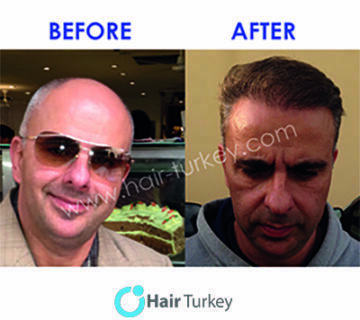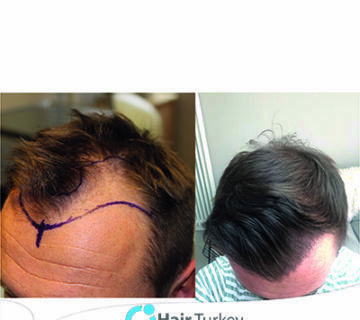What is PRP for Hair Loss?
PRP (platelet-rich plasma) is a nonsurgical hair-loss treatment that stimulates the activity of the hair follicles and promote new hair growth. The procedure of PRP or platelet-rich plasma therapy for hair is is considered a safe, relatively inexpensive, and less invasive option. PRP can be performed with or without hair transplant surgery or the other hair loss treatments. PRP for hair loss treatment when compared with hair transplant procedure, helps to enhance the metabolism of the grafts and nutrition.
There are many treatment options for hair loss. Most hair loss treatment programs include a multifaceted approach. The initial consultation with the medical provider will help to determine what are the underlying causes of individuals thinning hair. After a several analysis (such as medical lab work-up to determine any exacerbating conditions, and microscopic photos of the scalp and hair follicles) your healthcare provider will decide which hair loss treatment is the best option for the individual. Mostly, it is considered more beneficial to combine treatments to get permanent results.
Hair loss and thinning hair are common problem for both men and women. PRP can be an effective treatment for both age-related hair loss and alopecia areata (male pattern baldness).
PRP Therapy Process For Hair Loss…
PRP injection treatment starts with drawing a patient’s own blood and processing it so only the enriched cells remain. PRP hair loss treatment is a process that takes around 45-50 minutes. It is a safe procedure which can be performed in a clinic without anesthesia.
PRP is performed by platelets extracted from your own blood’s injected into areas of your scalp, to restore thinning hair. Prepared PRP injections contains growth factors. These factors helps to restore damaged skin and accelerate the healing process for wounds and injuries. In other words, PRP is the treatment that stimulates the dormant hair follicles to grow.
PRP treatment contains 3 steps;
1- PRP injection preparation starts with the doctors drawing the blood from the individuals arm and stores it in a sterile, airtight tube.
2- Separating platelets is the second step. To separate platelets the lab technician will put the tube in a centrifuge and spin it for 10 minutes. This process separates the red blood cells (that settles bottom of the tube), serum (top layer), and platelets (middle layer).
3- PRP injection into the scalp is the last step of the process. In this process the platelets will drawn from the tube with the help of a syringe and injected into area wherever there is hair thinning and balding.
PRP treatment also certainly helps during the healing process of hair transplant. The day before the hair transplant the individual may consider to choose PRP treatment.
PRP can also be paired with microneedling to produce new collagen. According to the studies this combination is highly effective in the management of androgenetic and androgenic alopecia (aka female pattern baldness).
PRP for hair loss therapy generally begins to work after one or two treatments. You’ll need up to six treatments, spaced four to six weeks apart.
How Painful is PRP Injection For Hair Loss?
PRP injections are done with a numbing cream. So, the individual feels less pain. If we have to give a score to the pain level we can say that PRP injections for hair loss therapy from 1 to 10 rate it will be in 2-3 scale. In some cases individuals reports that they had experienced burning when injected. The type of coagulant used may cause burning. If the individual’s can’t stand the pain then the doctor may consider using a local anesthesia.
What are The Pros and Cons of PRP for Hair Loss?
Pros
- PRP therapy is a nonsurgical procedure.
- The entire procedure takes only around 45 minutes.
- Studies shows that both men and women have positive results in terms of increased hair thickness and regrowth although the main objective of the PRP is to slow down the progression of hair loss.
- Average cost of PRP for hair loss is less than hair transplant surgery
Cons
- There are some risks and side effects for the individuals who take PRP injections for hair loss such as; mild pain at the injection site, scalp tenderness, swelling, headache, itching and temporary bleeding at the injection site.
- The results are not permanent so the individual will need to start and repeated treatments every few months afterward.
- The success of PRP injections changes due to the factors that the individuals has such as amount and space of the hair loss. If the individual’s baldness is long-standing with large areas, than PRP by it is own is not a right solution.
How long does PRP For Hair Loss Recovery take?
Within about four months the individuals will get PRP for hair loss results. During the PRP for hair loss it is common to experience some bruising, soreness, and swelling at the injection site. These side effects will last for 3 to 10 days and will turn back to normal by it is own. It is important to learn what to “do and don’t” will help you during the recovery time.
PRP for hair loss has quick recovery time. It lets the individual to resume usual activities immediately without any interruption.
Do;
- Drink water! Drinking water has many positive effects on healing. Starting from the day of your injections and during the week after drink water as many as you can.
- Pay Attention On the Medicines! After the PRP treatment the individuals doctor will give some medicines that will increase the comfort level. Don’t take any other medicine without any doctor suggestion.
Don’ts;
- After PRP injections the individual has to avoid taking shower before 6 hours. Right after the PRP injection any change in temperature responses has negative effects on the results.
- Avoid putting on makeup, lotions, or creams, on the injected area for at least six hours.
- It is important not to do any strenuous activity or vigorous exercise. Although PRP for hair loss is a nonsurgical procedure increase in body temperature is not recommended.
- For three days after PRP treatment avoid direct sun exposure.
- Before and after at least 3 days don’t smoke and avoid alcohol



